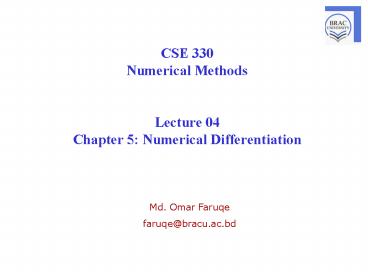CSE 330 Numerical Methods Lecture 04 Chapter 5: Numerical Differentiation - PowerPoint PPT Presentation
1 / 23
Title:
CSE 330 Numerical Methods Lecture 04 Chapter 5: Numerical Differentiation
Description:
Title: Numerical Methods Lecture 10 Last modified by: faruqe Created Date: 1/24/2006 4:08:18 AM Document presentation format: On-screen Show Other titles – PowerPoint PPT presentation
Number of Views:570
Avg rating:3.0/5.0
Title: CSE 330 Numerical Methods Lecture 04 Chapter 5: Numerical Differentiation
1
CSE 330Numerical Methods Lecture 04Chapter
5 Numerical Differentiation
Md. Omar Faruqe faruqe_at_bracu.ac.bd
2
Introduction
- Definition
- Numerical differentiation is the process of
calculating the derivatives of a function from a
set of given values of that function. - How to Solve
- The problem is solved by
- Representing the function by an interpolation
formula. - Then differentiating this formula as many times
as desired.
3
Differentiation for Equidistant and
Non-equidistant Values
- If the function is given by equidistant values,
it should be represented by an interpolation
formula employing differences, such as Newtons
formula. - If the given values of the function are not
equidistant, we must represent the formula by
Lagranges formula.
4
Numerical Differentiation
- Consider Newtons Forward difference formula,
putting u (x - x0)/h, we get
- Then,
5
Numerical Differentiation
- Therefore,
6
Numerical Differentiation
For tabular values of x, the formula takes a
simpler form, by setting x x0 we obtain u 0
since u (x - x0)/h and hence (1.1) gives
7
Numerical Differentiation Double Derivatives
Differentiating (1.1) again, we obtain,
From which we obtain
Formulae for computing higher derivatives may be
obtained by successive differentiation.
8
Numerical Differentiation Higher Derivatives
- Different formulae can be derived by starting
with other interpolation formulae. - (a) Newtons backward difference formula gives
9
Numerical Differentiation Higher Derivatives
If a derivative is required near the start of a
table the following formulae may be used
10
Numerical Differentiation Higher Derivatives
If a derivative is required near the end of a
table the following formulae may be used
11
Example
From the following table of values of x and y,
obtain
x 1.0 1.2 1.4 1.6 1.8 2.0 2.2
y 2.7183 3.3201 4.0552 4.953 6.0496 7.3891 9.025
Solution
The difference table is in the next slide
12
Solution
y0
x0
? y0
?2 y0
?3 y0
?4 y0
?5 y0
13
Solution
Here x0 1.2, y0 3.3201 and h 0.2
14
Alternative Solution
Here x0 1.2, y0 3.3201 and h 0.2 Then, x-1
1.0, y-1 2.7183 and h 0.2
15
Class Work
From the following table of values of x and y,
obtain
x 1.0 1.2 1.4 1.6 1.8 2.0 2.2
y 2.7183 3.3201 4.0552 4.953 6.0496 7.3891 9.025
Answer 7.3896
16
Class Work
Find x 0.1 from the
following table
x 0.0 0.1 0.2 0.3 0.4
J0(x) 1.0000 0.9975 0.9900 0.9776 0.9604
17
Class Work
The following table gives the angular
displacements ? (radians) at different intervals
of time t (seconds). Calculate the angular
velocity at the instant x 0.04.
? 0.052 0.105 0.168 0.242 0.327 0.408 0.489
t 0 0.02 0.04 0.06 0.08 0.10 0.12
18
Errors in Numerical Differentiation
In the given example,
x 1.0 1.2 1.4 1.6 1.8 2.0 2.2
y 2.7183 3.3201 4.0552 4.953 6.0496 7.3891 9.025
- Therefore, here we can see with each
differentiation, some error occurs in the
derivatives. - The error increases with higher derivatives.
- This is because, in interpolation the new
polynomial would agree at the set of points. - But, their slopes at these points may vary
considerably.
19
Maximum Value of a Tabulated Function
- It is known that the maximum values of a
function can be found by equating the first
derivative to zero and solving for the variable. - The same procedure can be applied to determine
the maxima of a tabulated function. - Consider Newtons forward difference formula
20
Maximum Value of a Tabulated Function
- For maxima, dy/dx 0.
- Hence, terminating the right-hand side after the
third difference (for simplicity) and equating it
to zero. - We obtain the quadratic for u.
The values of x can then be found from the
relation x x0uh
21
Example
From the following table, find x, correct to two
decimal places, for which y the function has the
maximum value and find the value of y.
x 1.2 1.3 1.4 1.5 1.6
y 0.9320 0.9636 0.9855 0.9975 0.9996
Solution
The difference table is in the next slide
22
Solution
x y
1.2 0.9320
0.0316
1.3 0.9636 -0.0097
0.0219
1.4 0.9855 -0.0099
0.0120
1.5 0.9975 -0.0099
0.0021
1.6 0.9996
23
Solution
Let, x0 1.2 and we can terminate the formula
after the second difference (since the difference
is very negligible). Now we have, 0.0316(2u
1)(-0.0097)/2 0 Therefore, u 3.8 and x x0
uh 1.2(3.8)(0.1) 1.58 For x 1.58, we have
the maximum value of y. Using Newtons backward
difference formula at xn 1.6 gives, y(1.58)
1.0 (CLASS WORK) That is the maximum value of y
in the function.































